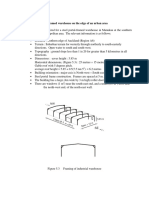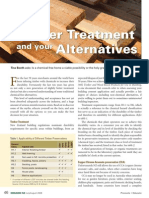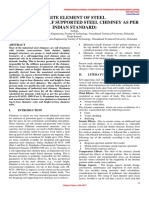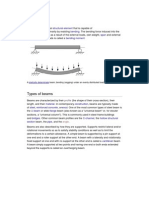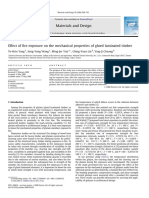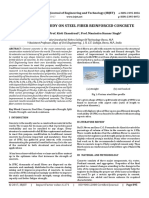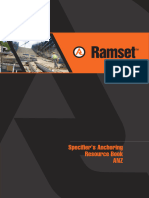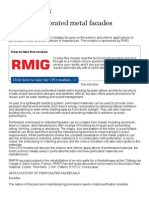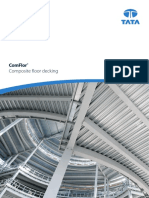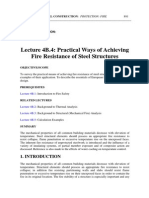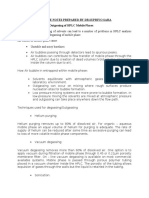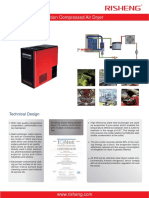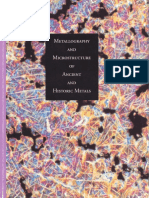Steel Properties
Steel Properties
Uploaded by
Nurul AkmaCopyright:
Available Formats
Steel Properties
Steel Properties
Uploaded by
Nurul AkmaCopyright
Available Formats
Share this document
Did you find this document useful?
Is this content inappropriate?
Copyright:
Available Formats
Steel Properties
Steel Properties
Uploaded by
Nurul AkmaCopyright:
Available Formats
Steel Properties
When selecting a material for a particular application, engineers must be confident that it will be suitable for the loading conditions and environmental challenges it will be subjected to while in service. Understanding and control of a materials properties is therefore essential. The mechanical properties of steel can be carefully controlled through the selection of an appropriate chemical composition, processing and heat treatment, which lead to its final microstructure. The alloys and the heat treatment used in the production of steel result in different property values and strengths and testing must be performed to determine the final properties of a steel and to ensure adherence to the respective standards. There are many measurement systems used to define the properties of a given steel. For example, Yield strength, ductility and stiffness are determined using tensile testing. Toughness is measured by impact testing; and hardness is determined by measuring resistance to the penetration of the surface by a hard object. Tensile testing is a method of evaluating the structural response of steel to applied loads, with the results expressed as a relationship between stress and strain. The relationship between stress and strain is a measure of the elasticity of the material, and this ratio is referred to as Young's modulus. A high value of Young's modulus is one of steels most differentiating properties; it is in the range 190-210 GPa, which is approximately three times the value for aluminum. The physical properties of steel are related to the physics of the material, such as density, thermal conductivity, elastic modulus, Poisons ratio etc. Some typical values for physical properties of steel are:
density = 7.7 8.1 [kg/dm3] elastic modulus E=190210 [GPa] Poissons ratio = 0.27 0.30 Thermal conductivity = 11.2 48.3 [W/mK] Thermal expansion = 9 27 [10-6 / K]
Reference: http://www.keytometals.com/page.aspx?ID=SteelProperties&LN=EN
Mild and low carbon steel
Mild steel is the most common form of steel because its price is relatively low while it provides material properties that are acceptable for many applications. Low carbon steel contains approximately 0.050.25% carbon[1] and mild steel contains 0.160.29%[1] carbon; therefore, it is neither brittle nor ductile. Mild steel has a relatively low tensile strength, but it is cheap and malleable; surface hardness can be increased through carburizing.[3] It is often used when large quantities of steel are needed, for example as structural steel. The density of mild steel is approximately 7.85 g/cm3 (7850 kg/m3 or 0.284 lb/in3)[4] and the Young's modulus is 210 GPa (30,000,000 psi).[5] Low carbon steels suffer from yield-point runout where the material has two yield points. The first yield point (or upper yield point) is higher than the second and the yield drops dramatically after the upper yield point. If a low carbon steel is only stressed to some point between the upper and lower yield point then the surface may develop Lder bands.[6]
[edit] Higher carbon steels
Carbon steels which can successfully undergo heat-treatment have a carbon content in the range of 0.301.70% by weight. Trace impurities of various other elements can have a significant effect on the quality of the resulting steel. Trace amounts of sulfur in particular make the steel red-short. Low alloy carbon steel, such as A36 grade, contains about 0.05% sulfur and melts around 14261538 C (25992800 F).[7] Manganese is often added to improve the hardenability of low carbon steels. These additions turn the material into a low alloy steel by some definitions, but AISI's definition of carbon steel allows up to 1.65% manganese by weight.
Medium carbon steel
Approximately 0.300.59% carbon content.[1] Balances ductility and strength and has good wear resistance; used for large parts, forging and automotive components.[8]
High carbon steel
Approximately 0.60.99% carbon content.[1] Very strong, used for springs and high-strength wires.[9]
Ultra-high carbon steel
Approximately 1.02.0% carbon content.[1] Steels that can be tempered to great hardness. Used for special purposes like (non-industrial-purpose) knives, axles or punches. Most steels with more than 1.2% carbon content are made using powder metallurgy. Note that steel with a carbon content above 2.0% is considered cast iron.
Reference : http://en.wikipedia.org/wiki/Carbon_steel
You might also like
- Assignment 4 Weatherproofing - 2021Document4 pagesAssignment 4 Weatherproofing - 2021Nisha PrakashNo ratings yet
- Australian Standard: Masonry StructuresDocument9 pagesAustralian Standard: Masonry StructuresChester Feng50% (2)
- Australian Standard: Timber Structures Part 1: Design MethodsDocument8 pagesAustralian Standard: Timber Structures Part 1: Design MethodswilliamrahilyNo ratings yet
- Development of Interlocking Lightweight Cement Blocks: December 2013Document10 pagesDevelopment of Interlocking Lightweight Cement Blocks: December 2013Jackel BeanNo ratings yet
- Comparative Seismic Analysis Study of G+ 20 Story Building With Flat Slab and Conventional Slab Using ETABSDocument9 pagesComparative Seismic Analysis Study of G+ 20 Story Building With Flat Slab and Conventional Slab Using ETABSIJRASETPublicationsNo ratings yet
- Chapter 5.3rDocument16 pagesChapter 5.3rLampard ChenNo ratings yet
- Failure Studies in Materials - ch8Document47 pagesFailure Studies in Materials - ch8tamailhamNo ratings yet
- BS6399 3 1988Document31 pagesBS6399 3 1988Khaled Fada'aq100% (1)
- Timber Vs Steel Vs Concrete StructuresDocument10 pagesTimber Vs Steel Vs Concrete StructuresscegtsNo ratings yet
- Steel Lecture 3 - Tension MembersDocument111 pagesSteel Lecture 3 - Tension MembersSana'a AamirNo ratings yet
- Industrial Building: by Tausif Kauswala Adit College V.V. Nagar, Anand, Gujarat, IndiaDocument59 pagesIndustrial Building: by Tausif Kauswala Adit College V.V. Nagar, Anand, Gujarat, IndiaPhuong ThaoNo ratings yet
- L4-Steel Work Part 1a - Connection and Fire ProtectionDocument33 pagesL4-Steel Work Part 1a - Connection and Fire ProtectionTjia TjieNo ratings yet
- Timber Treatment Alternatives Organicnz Jul Aug 08Document4 pagesTimber Treatment Alternatives Organicnz Jul Aug 08Tina MacnicolNo ratings yet
- Q1.What Are Cable Structures? What Are Their Different Types, and Principle of DesignDocument20 pagesQ1.What Are Cable Structures? What Are Their Different Types, and Principle of DesignTEHREEM ZAHRANo ratings yet
- Analysis & Design of Innovative Industrial Roof: Arpita Nikam, Priyanka JoshilkarDocument9 pagesAnalysis & Design of Innovative Industrial Roof: Arpita Nikam, Priyanka Joshilkardino mohammedNo ratings yet
- Planning, Analyzing and Designing of Staff Quaters Building by Using STAAD ProDocument12 pagesPlanning, Analyzing and Designing of Staff Quaters Building by Using STAAD ProInternational Journal of Application or Innovation in Engineering & ManagementNo ratings yet
- Lecture 1Document72 pagesLecture 1Engr.Muhammad TufailNo ratings yet
- Pre - Engineered BuildingDocument30 pagesPre - Engineered BuildingEL GADOL GIBOR YARENo ratings yet
- Acrow PropDocument2 pagesAcrow Proptrozza28No ratings yet
- Chapter 5.2r PDFDocument13 pagesChapter 5.2r PDFLampard ChenNo ratings yet
- Lecture 3 - Analysis and Design For Axial TensionDocument10 pagesLecture 3 - Analysis and Design For Axial TensionDubu DubuNo ratings yet
- Finite Element of Steel (Analysis of Self Supported Steel Shimney As Per Indian Standard)Document2 pagesFinite Element of Steel (Analysis of Self Supported Steel Shimney As Per Indian Standard)chaly37No ratings yet
- Hyperbolic Cooling Towers - DetailsDocument13 pagesHyperbolic Cooling Towers - DetailsAnonymous YcAZv5qF67No ratings yet
- GUIDE On Importing ETABS Thermal Model To SAFEDocument4 pagesGUIDE On Importing ETABS Thermal Model To SAFEMara Pearl Domingo-BonitaNo ratings yet
- "Hybrid" Light Steel Panel and Modular Systems PDFDocument11 pages"Hybrid" Light Steel Panel and Modular Systems PDFTito MuñozNo ratings yet
- Study of Strength of RC Shear Wall at Different Location On Multi-Storied Residential BuildingDocument6 pagesStudy of Strength of RC Shear Wall at Different Location On Multi-Storied Residential BuildingSyed Ehtesham AliNo ratings yet
- Beam, Frame TrussDocument3 pagesBeam, Frame TrussKrishna MyakalaNo ratings yet
- Advanced Design of Steel and Concrete Composite StructuresDocument19 pagesAdvanced Design of Steel and Concrete Composite StructuresCristian BlanaruNo ratings yet
- Prefabrication, Systems Building and Mixed/Composite: Presented byDocument15 pagesPrefabrication, Systems Building and Mixed/Composite: Presented byPrasanna ChaurasiaNo ratings yet
- Design of Roof SystemDocument3 pagesDesign of Roof SystemkarthikuddNo ratings yet
- Answer of QuestionsDocument3 pagesAnswer of QuestionsItaakNo ratings yet
- CVEN3302 Structural Design CVEN3302 Structural DesignDocument404 pagesCVEN3302 Structural Design CVEN3302 Structural Designroy jackNo ratings yet
- Product Catalogue: Rawlplug LTDDocument154 pagesProduct Catalogue: Rawlplug LTDhemendraengNo ratings yet
- RCC 1 PDFDocument8 pagesRCC 1 PDFNgọc TuyênNo ratings yet
- 05450-Pre Engineered Metal TrussesDocument4 pages05450-Pre Engineered Metal TrussesRamsey RasmeyNo ratings yet
- Hollow Core Tech DataDocument1 pageHollow Core Tech Datacr231181100% (1)
- BLD 305 Design and DetailingDocument61 pagesBLD 305 Design and DetailingJoshua AbubakarNo ratings yet
- Steel Structure-Study: Aditi ManojDocument7 pagesSteel Structure-Study: Aditi ManojAditi Manoj.S0% (1)
- Second Order EffectDocument2 pagesSecond Order Effectshantanu chowdhuryNo ratings yet
- Chapteer 2 Bolted ConnectionDocument30 pagesChapteer 2 Bolted ConnectionNamrata PalNo ratings yet
- PurlinDocument10 pagesPurlinKhairul JaggerNo ratings yet
- Design of Shear Reinforcement in A Singly Reinforced BeamDocument8 pagesDesign of Shear Reinforcement in A Singly Reinforced BeamyousufNo ratings yet
- Effect of Fire Exposure On The Mechanical Properties of Glue Laminated TimberDocument6 pagesEffect of Fire Exposure On The Mechanical Properties of Glue Laminated Timbersnrivs99No ratings yet
- FM 2 Flooring Journel PDFDocument4 pagesFM 2 Flooring Journel PDFkamaldeep singhNo ratings yet
- Ramset SRB 2015Document332 pagesRamset SRB 2015YousefNo ratings yet
- Functionally Graded BeamsDocument10 pagesFunctionally Graded BeamsHakim KaciNo ratings yet
- Lecture 3 Axially Loaded MembersDocument59 pagesLecture 3 Axially Loaded MembersCyrus HongNo ratings yet
- CPD 25 - Perforated Metal Facades - Magazine Features - BuildingDocument6 pagesCPD 25 - Perforated Metal Facades - Magazine Features - BuildingTommy YapNo ratings yet
- Epoxy Connection TimberDocument6 pagesEpoxy Connection TimberJeffery RoweNo ratings yet
- Design of Steel and Timber StructuresDocument6 pagesDesign of Steel and Timber StructuresYi MokNo ratings yet
- Clading (Protecion Mecanica) PDFDocument12 pagesClading (Protecion Mecanica) PDFManuel MarrugoNo ratings yet
- Assignment On Bolted, Riveted and Welded JointDocument4 pagesAssignment On Bolted, Riveted and Welded JointRitesh SinghNo ratings yet
- Introduction To Construction Management OneDocument76 pagesIntroduction To Construction Management OneYohannes TesfayeNo ratings yet
- Overall Buckling Behaviour and Design of High-Strength Steel Welded Section Columns, 2018 (Huiyong Ban)Document16 pagesOverall Buckling Behaviour and Design of High-Strength Steel Welded Section Columns, 2018 (Huiyong Ban)Phan Đào Hoàng HiệpNo ratings yet
- Dome Structures. Saldome 2Document6 pagesDome Structures. Saldome 2Lidhia Fairuz HarlyNo ratings yet
- Column Design As Per BS 8110-1:1997: PHK/JSNDocument16 pagesColumn Design As Per BS 8110-1:1997: PHK/JSNShabana ferozNo ratings yet
- Comflor: Composite Floor DeckingDocument32 pagesComflor: Composite Floor DeckingjparsbNo ratings yet
- Practical Ways of Achieving Fire Resistance of Steel StructuresDocument19 pagesPractical Ways of Achieving Fire Resistance of Steel StructuresMihajloDjurdjevicNo ratings yet
- Structural Design and Construction of The Foundation of Tokyo Sky TreeDocument12 pagesStructural Design and Construction of The Foundation of Tokyo Sky TreeKaung Htet100% (1)
- Structural Engineering DocumentsFrom EverandStructural Engineering DocumentsJorge de BritoNo ratings yet
- The Mechanical Properties of SteelDocument13 pagesThe Mechanical Properties of SteelAddrien DanielNo ratings yet
- Lecture Notes Prepared by DR - Supriyo Saha Importance of Degassing/Outgassing of HPLC Mobile PhaseDocument4 pagesLecture Notes Prepared by DR - Supriyo Saha Importance of Degassing/Outgassing of HPLC Mobile PhasesupriyoNo ratings yet
- Characteristics: C5 Petrochemical ProductDocument3 pagesCharacteristics: C5 Petrochemical ProductPeter PandaNo ratings yet
- Pembahasa Bundelan Piperin N KMnO4 ANASDocument8 pagesPembahasa Bundelan Piperin N KMnO4 ANASharrysalle100% (1)
- New Brochure 20pagesDocument20 pagesNew Brochure 20pagesSikander0% (1)
- Welding SeminarDocument18 pagesWelding SeminarJc Baril LlegueNo ratings yet
- SUPER SPAN Design GuideDocument20 pagesSUPER SPAN Design GuideEdwin Tunque RaymundoNo ratings yet
- Electrostatic Discharge - Semiconductor PDFDocument24 pagesElectrostatic Discharge - Semiconductor PDFMifzal IzzaniNo ratings yet
- Metallography PDFDocument185 pagesMetallography PDFTunjung Harry MuktiNo ratings yet
- Vacuum Tubes and Semiconductor Theory: Prepared By: Villanueva, Carmelo RDocument83 pagesVacuum Tubes and Semiconductor Theory: Prepared By: Villanueva, Carmelo RReynald John PastranaNo ratings yet
- Iso 4586Document14 pagesIso 4586ms_macadamiaNo ratings yet
- Arease: Nov. 8, 1966 W. Wogt Et Al 3,284,495 Process For The Continuous Manufacture, Purification andDocument3 pagesArease: Nov. 8, 1966 W. Wogt Et Al 3,284,495 Process For The Continuous Manufacture, Purification andRachmad HermawanNo ratings yet
- Waste Management: V.E. Messerle, A.L. Mosse, A.B. UstimenkoDocument9 pagesWaste Management: V.E. Messerle, A.L. Mosse, A.B. Ustimenkovitor_alberto_7No ratings yet
- FM Global Property Loss Prevention Data Sheets: List of FiguresDocument12 pagesFM Global Property Loss Prevention Data Sheets: List of Figurescsoluciones industrialesNo ratings yet
- Letter For Feild Compressive Strength Test 1Document2 pagesLetter For Feild Compressive Strength Test 1Pja Shantha100% (1)
- Redox ReactionDocument11 pagesRedox ReactionAmeya GuptaNo ratings yet
- Conflict Minerals Reporting Template (CMRT) : Link To Terms & ConditionsDocument3 pagesConflict Minerals Reporting Template (CMRT) : Link To Terms & ConditionsDevika raksheNo ratings yet
- CO2 TOTAL FLOODING SYSTEM MANUAL Part IIDocument24 pagesCO2 TOTAL FLOODING SYSTEM MANUAL Part IIBhavesh NikamNo ratings yet
- P-205-05 Current Transformers For Special ApplicationDocument16 pagesP-205-05 Current Transformers For Special ApplicationSarmad HussainNo ratings yet
- Sample: Exhibit 1 Exhibit 1Document1 pageSample: Exhibit 1 Exhibit 1jessy eghNo ratings yet
- Rcd-I SyllabusDocument2 pagesRcd-I SyllabusDr. M.V.Krishna RaoNo ratings yet
- Homemade Explosives Recognition Guide USA 2010Document58 pagesHomemade Explosives Recognition Guide USA 2010jaml6491% (11)
- Experiment 1 - Basic Chem FARISHDocument8 pagesExperiment 1 - Basic Chem FARISHMUHAMMAD FAIDZ DARWISH BIN FAIDZAL MoeNo ratings yet
- 85 RDGJ 478 GDocument10 pages85 RDGJ 478 GGanda PrajaNo ratings yet
- WT SyllabusDocument1 pageWT SyllabuschandrasekarcncetNo ratings yet
- Art 18 Advantages of Anotec Z Series Anodes Rev00Document3 pagesArt 18 Advantages of Anotec Z Series Anodes Rev00fb4scribdNo ratings yet
- Applied Physics Question Paper 45Document1 pageApplied Physics Question Paper 45RA.......VANo ratings yet
- Carcd 161201130828Document21 pagesCarcd 161201130828Ganesh Peketi100% (1)
- Road BSR 2022 (Wef 01-03-2023)Document75 pagesRoad BSR 2022 (Wef 01-03-2023)Nishant KediaNo ratings yet
- Reference Tables For ManningDocument5 pagesReference Tables For Manningraudelmoreno83No ratings yet





